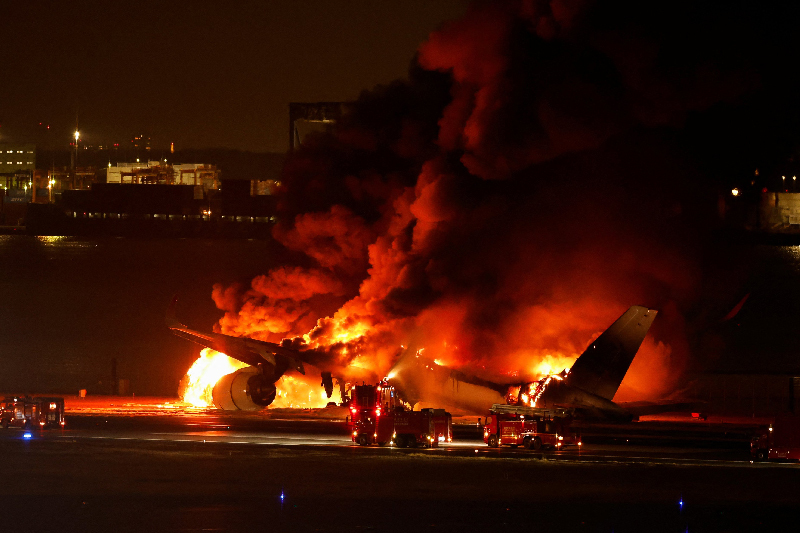
Fatal Flames: Haneda Airport Gripped by Japan Airlines Collision
A Devastating Incident Unfolds
In a tragic turn of events at Tokyo’s Haneda Airport, a Japan Airlines plane met a catastrophic fate, erupting into flames after an apparent collision with a coast guard aircraft. The incident, which claimed the lives of five individuals, unfolded in a harrowing spectacle witnessed by onlookers and reported by various media outlets.
As captured by images on broadcaster NHK, the ill-fated plane was observed moving along the runway before an explosion of orange flames burst forth from beneath and behind it. The intensity of the incident sent shockwaves through the aviation community and beyond, leaving questions lingering about the cause and repercussions of the collision.
Fatalities and Evacuations
Reports indicate that all 367 passengers and 12 crew members aboard the Airbus plane were successfully evacuated. However, the tragic loss of five lives occurred among those on board the coast guard aircraft. The gravity of the situation is emphasized by the fact that the casualties include eight children, as reported by Kyodo News.
Unaccounted Crew Members
NHK reported that of the six crew members on the coast guard plane, one was reported safe, leaving the fate of the other five unaccounted for. The uncertainty surrounding their condition adds another layer of distress to an already somber incident.
Unraveling the Mystery
The cause of the collision remains shrouded in ambiguity, with television reports suggesting that the Airbus collided with the coast guard aircraft. The Jiji news agency disclosed that the coast guard plane was scheduled to depart for rescue efforts following a massive earthquake in central Japan the previous day. The Airbus had just arrived from Sapporo airport on the northern Japanese island of Hokkaido, adding complexity to the investigation.
JAL (Japan Airlines) reported that the passenger plane either collided with the other aircraft on a runway or a taxiway after touchdown. This conflicting information underscores the need for a thorough investigation to ascertain the sequence of events leading to this catastrophic incident.
On-site Response and Closure
The Ministry of Land, Infrastructure, Transport, and Tourism swiftly initiated an inquiry into the incident. The television footage revealed rescue workers battling flames, with more than 70 fire engines deployed to contain the situation. The airport, one of the world’s busiest, was reported closed to traffic, further disrupting air travel.
As Japan grapples with the aftermath of this aviation tragedy, the haunting images of flames engulfing the plane and the tireless efforts of rescue teams will remain etched in the collective memory. It’s a stark reminder of the inherent risks associated with air travel and the need for stringent safety measures.
Japan has been fortunate to avoid serious commercial aviation accidents for decades. The worst aviation disaster in its history occurred in 1985 when a JAL jumbo jet crashed in central Gunma region, claiming the lives of 520 passengers and crew.
Conclusion: Reflections on a Tragedy
In the wake of this heart-wrenching incident, questions loom about the future of aviation safety protocols, the outcome of the investigation, and the collective grief shared by those affected. The aviation industry, as well as the global community, awaits answers and reassurances that such a tragedy will be prevented in the future.




